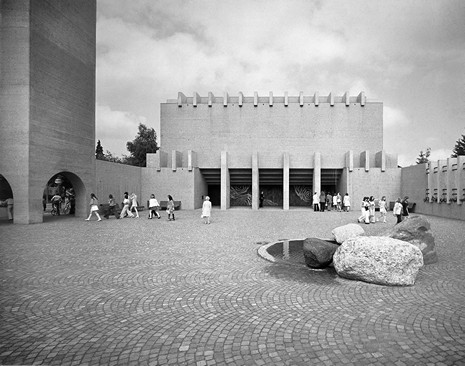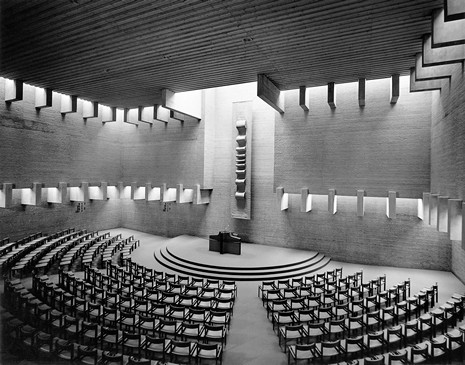Description
Surrounded on three sides by traffic noise, the church adopts a withdrawn position from the street. The complex is enclosed by a ring-wall that is only open in two places: a flight of steps to the north, and four rounded arches at the base of the tower to the south. The parts of the building to the east provide facilities for social and cultural activities; here an older parish hall has been extended with three new wings around a new green courtyard in the middle. The parts of the building to the west encompass the main church, the wing containing a room for devotions, the parish rooms, the verger’s residence and the 35 metre high tower with its six bells. The ensemble surrounds a paved court. This, together with the church, forms a rectangle of 51.5 by 23 metres.
The architects gave the church project the name “cella”. It has resulted in a piece of extremely concentrated architecture. Due to its surroundings, the building presents a windowless exterior. The “bunker” is constructed almost entirely of concrete, with a brownish hue, roughened and textured with a hammer so that, at first sight, it looks like stone. The pre-fabricated, projecting concrete beams between the lower and upper levels and between walls and roof are smooth and grey. Slab columns and the stepped portal give the open entrance a somewhat sober feel. One enters the building through “Water and Fire”, to the left or right of a 14.5 metre wide and 2.3 metre high relief made of cast aluminium panels with a gold leaf depiction by Bernard Schorderet.
The volume of the church gives the impression of a half cube. It is, however, not without direction. On the contrary, the gently sloping floor towards the 9.8 metre high front wall, the placing of the 450 chairs in three sections, the semicircular stage of the altar and the rooflight above it establish a clear orientation.
To emphasise the liturgical focus of the space, a single, partly copper and partly glass element serves simultaneously as altar, pulpit and font. This is also emphasised by the wavy copper-thread tapestry by Moik Schiele. The brown of the wall hanging, the green of the floor, the wooden ceiling and the grey of the projecting beams: the calm, earthy colouring is bathed in a constant matt sheen by the soft streaks of reflected light coming from all sides. Windows with a view to the outside would destroy this effect.
The design of Glaubten Church dates from the year 1965. It is able to combine modernity and classicism in a memorable way. The béton brut and the relationship between wall elements and projecting beams can be seen to relate to individual works by Kenzo Tange or Paul Rudolph. The dominant campanile however boasts other influences. This sort of italianità with veiled references to the Romanesque period, the Renaissance and the rationalism of the twenties and thirties is a precious rarity in the middle of the sixties north of the Alps.
Architecture and Urbanism, no. 12/1981, pp. 59- | Evangelisch-Reformierte Kirchenpflege Zürich-Affoltern (Ed.): Einweihung Kirchliches Zentrum Glaubten Zürich-Affoltern, Festschrift, Zurich 1972 | Faith and Form, no. Spring/1984, p. 29 | Ineichen, Hannes (Ed.): Rudolf und Esther Guyer. Bauten und Projekte 1953-2001, Monografien Schweizer Architekten und Architektinnen, Vol. 4, Blauen 2002, pp. 136-, p. 283 | Rucki, Isabelle, Huber, Dorothee (Ed.): Architektenlexikon der Schweiz 19./20. Jahrhundert, Basel 1998, p. 243
Drawings
Site plan
Ground floor
Longitudinal section
South elevation
Photos

Churchyard with the base of the tower on the left, in the background the entrance to the church with the cast aluminium panels of the relief “Water and Fire” by Bernard Schorderet

Main church showing the combined altar, pulpit and font, hung below the rooflight the wall tapestry by Moik Schiele
Originally published in: Rudolf Stegers, Sacred Buildings: A Design Manual, Birkhäuser, 2008.